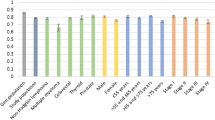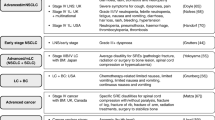Abstract
Introduction
The Functional Assessment of Cancer Therapy-Lung (FACT-L) is a validated, sensitive and reliable patient questionnaire that evaluates and quantifies quality of life (QOL) across several domains, including lung cancer-related symptoms. The FACT-L was not designed for use in economic evaluation and does not incorporate preferences into its scoring system.
Objective
To derive a set of Dutch preference weights for FACT-L health states that can be used to convert FACT-L into a single value that can be used in cost-utility analyses.
Methods
A representative sample of the Dutch population (n = 1076) directly valued an orthogonal set of eight FACT-L health states on a 100-point rating scale with the anchor points ‘worst imaginable health state’ and ‘best imaginable health state’. Eleven FACT-L items were selected to describe the FACT-L health states that were directly valued. Regression analysis was used to interpolate values for all other possible health states. Scores were transformed into values on a scale where 0 indicated dead and 1 indicated full health.
Results
The estimated values for FACT-L health states ranged from 0.08 to 0.93. The estimated value sets were applied to FACT-L data of lung cancer patients participating in a clinical study. Significant differences in the mean value and mean gain of 0.12 and 0.07, respectively, were found between patients in remission and patients with progressive disease at 4 weeks’ follow-up.
Conclusion
Our results reaffirmed that the methodology used here is a feasible option to convert data collected with a disease-specific outcome measure into preferences. We concluded that the sensitivity of the derived set of societal preferences to capture differences and changes in clinical health states is an indication of its construct validity.






Similar content being viewed by others
Notes
The use of trade names is for product identification purposes only and does not imply endorsement.
References
Drummond MF, Sculpher MJ, Torrance GW, et al. Methods for the economic evaluation of health care programmes. Third edition. Oxford University Press: New York, 2005
Dolan P. The measurement of health-related quality of life for use in resource allocation decisions in health care. In: Cuyler AJ, Newhouse JP, editors. Handbook of health economics. Vol 1B. Elsevier Science: Amsterdam, 2000: 1723–1760
Brooks R. EuroQol: the current state of play. Health Policy 1996; 37: 53–72
Feeny D, Furlong W, Boyle M, et al. Multi-attribute health status classification systems: Health Utilities Index. PharmacoEconomics 1995; 7: 490–502
Feeny D, Furlong W, Torrance GW, et al. Multi-attribute and single-attribute utility functions for the Health Utilities Index mark 3 system. Med Care 2002; 40: 113–128
Brazier J, Roberts J, Deverill M. The estimation of a preference-based measure of health from the SF-36. J Health Econ 2002; 21: 271–292
Cella DF, Bonomi AE, Lloyd SR, et al. Reliability and validity of the Functional Assessment of Cancer Therapy-Lung (FACT-L) quality of life instrument. Lung Cancer 1995; 12: 199–220
Auchter RM, Scholtens D, Adak S, et al. Quality of life assessment in advanced non-small-cell lung cancer patients undergoing an accelerated radiotherapy regimen: report of ECOG study 4593. Int J Radiation Oncol Biol Phys 2001; 50 (5): 1199–1206
Moinpour CM, Lyons B, Grevstad PK, et al. Quality of life in advanced non-small-cell lung cancer: results of a Southwest Oncology Group randomized trial. Qual Life Res 2002; 11: 115–126
Cella D. Impact of ZD1839 on non-small cell lung cancer-related symptoms as measured by the Functional Assessment of Cancer Therapy-Lung Scale. Semin Oncol 2003; 30 (1) Suppl. I: 39–48
LoRusso PM, Herbst RS, Rischin D, et al. Improvements in quality of life and disease-related symptoms in phase I trials of the selective oral epidermal growth factor receptor tyrosine kinase inhibitor ZD1839 in non-small cell lung cancer and other solid tumors. Clin Cancer Research 2003; 9: 2040–2048
Tester WJ, Jin PY, Reardon DH, et al. Phase II study of patients with metastatic nonsmall cell carcinoma of the lung treated with paclitaxel by 3-hour infusion. Cancer 1997; 79 (4): 724–729
Cella D, Eton DT, Fairclough DL, et al. What is a clinically meaningful change on the Functional Assessment of Cancer Therapy-Lung (FACT-L) questionnaire? Results from Eastern Cooperative Oncology Group (ECOG) Study 5592. J Clin Epidemiol 2002; 55: 285–295
Roychowdhury DF, Desai P, Zhu YW. Paclitaxel (3 hour infusion) followed by carboplatin (24 hours after paclitaxel): a phase II study in advanced non-small cell lung cancer. Semin Oncol 1997; 24 Suppl. 12: 37–40
Brazier J, Dixon S. The use of condition-specific outcome measures in economic appraisal. Health Econ 1995; 4: 255–264
Chancellor JVM, Coyle D, Drummond MF. Constructing health state preference values from descriptive quality of life outcomes: mission impossible? Qual Life Res 1997; 6: 159–168
Bennett KJ, Torrance GW, Boyle MH, et al. Development and testing of a utility measure for major, unipolar depression (McSad). Qual Life Res 2000; 9: 109–120
Krahn M, Ritvo P, Irvine J, et al. Construction of the Patient-Oriented Prostate Utility Scale (PORPUS): a multiattribute health state classification system for prostate cancer. J Clin Epidemiol 2000; 53: 920–930
Torrance GW, Keresteci MA, Casey RW, et al. Development and initial validation of a new preference-based disease-specific health-related quality of life instrument for erectile function. Qual Life Res 2004; 13 (2): 349–359
Kok ET, McDonnell J, Stolk EA, et al. The valuation of the International Prostate Symptom Score (IPSS) for use in economic evaluations. Eur Urol 2002; 42: 491–497
Stolk EA, Busschbach JJV. Validity and feasibility of the use of condition-specific outcome measures in economic evaluation. Qual Life Res 2003; 12: 363–371
Kind P, Macran S. Eliciting social preference weights for Functional Assessment of Cancer Therapy-Lung health states. Pharmacoeconomics 2005; 23 (11): 1143–1153
Pickard AS, Dobrez D, Cella D. Eliciting social preference weights for Functional Assessment of Cancer Therapy-Lung health states [letter]. Pharmacoeconomics 2006; 24 (3): 293–294
Fukuoka M, Yano S, Giaccone G, et al. Multi-institutional randomized phase II trial of gefitinib for previously treated patients with advanced non-small-cell lung cancer. J Clin Oncol 2003 Jun 15; 21 (12): 2237–2246
Kris MG, Natale RB, Herbst RS, et al. Efficacy of gefitinib, an inhibitor of the epidermal growth factor receptor tyrosine kinase, in symptomatic patients with non-small cell lung cancer: a randomized trial. JAMA 2003 Oct 22; 290 (16): 2149–2158
Dolan P. Modeling valuations for EuroQol health states. Med Care 1997; 35: 1095–1108
Statistics Netherlands [online]. Available from URL: http://www.statline.cbs.nl. [Accessed 2006 Oct 2]
Lamers LM, McDonell J, Stalmeier PFM, et al. The Dutch tariff: results and arguments for an effective design of national EQ-5D valuation studies. Health Econ 2006; 15: 1121–1132
Gerard K, Dobson M, Hall J. Framing and labeling effects in health descriptions: quality adjusted life years for treatment of breast cancer. J Clin Epidemiol 1993; 46: 77–84
Bleichrodt H. A new explanation for the difference between time trade-off utilities and standard gamble utilities. Health Econ 2002; 11: 447–456
Brazier J, Green C, McCabe C, et al. Use of visual analog scales in economic evaluation. Expert Rev Pharmocoeconomics Outcomes Res 2003; 3: 293–302
Parkin D, Devlin N. Is there a case for using visual analogue scale valuations in cost-utility analysis? Health Econ 2006; 15: 653–664
Czoski-Murray C, Warren E, Chilcott J, et al. The clinical and cost-effectiveness of pioglitazone and rosiglitazone in the treatment of type 2 diabetes: a systematic review and economic evaluation. Health Technol Assess 2004; 8: 1–91
Acknowledgements
This study was sponsored by an unrestricted grant from AstraZeneca.The authors have no conflicts of interest that are directly relevant to the content of this study.
The authors thank Paul Kind and Sue Macran from the University of York for sharing their results on the qualitative evaluation of the FACT-L items and for cooperating on a common methodology during the first phase of this study. The authors would also like to thank Elly Stolk for her useful comments on an earlier version of the manuscript. An earlier version of this paper was presented at the Annual Meeting of the International Society of Quality of Life Research, Prague, Czech Republic, 12–15 November 2003.
Author information
Authors and Affiliations
Rights and permissions
About this article
Cite this article
Lamers, L.M., Groot, C.A.Ud. & Buijt, I. The Use of Disease-Specific Outcome Measures in Cost-Utility Analysis. Pharmacoeconomics 25, 591–603 (2007). https://doi.org/10.2165/00019053-200725070-00005
Published:
Issue Date:
DOI: https://doi.org/10.2165/00019053-200725070-00005




